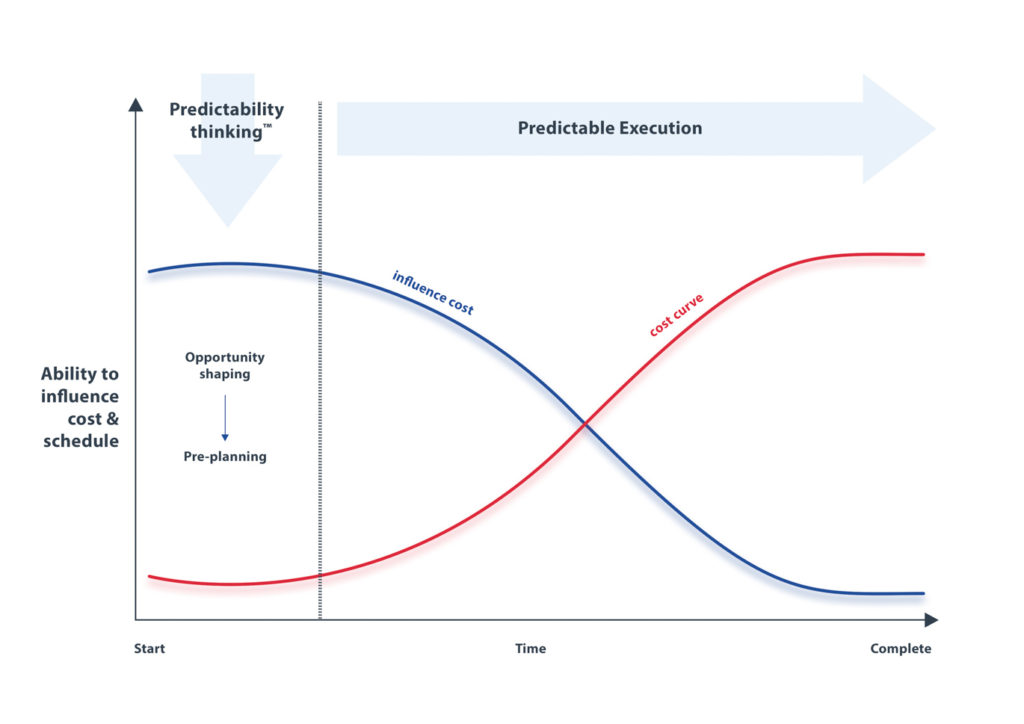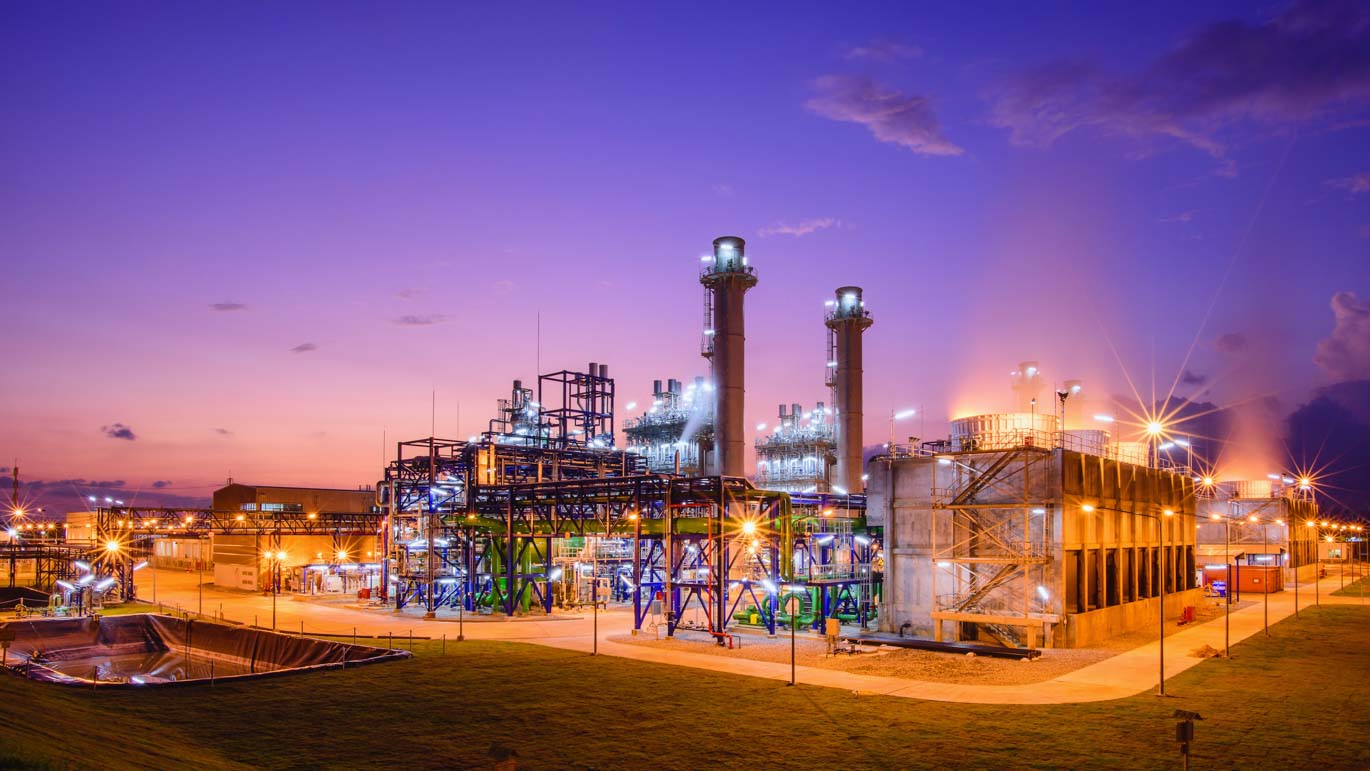Discover how to distinguish your organization from the competition by cultivating the ability to deliver on-time and on-budget
The vast majority of major capital projects are late and cost millions more than anticipated. By some estimates, fewer than one in 10 organizations can get the job done on-time and on-budget. It follows that one of the most powerful ways to distinguish yourself from the competition is to focus on predictability, so you become one of the elite few who can reliably deliver on-time and on-budget. How do achieve predictable gas power plant development?
Achieving predictable project delivery like this requires a great deal of focused effort on the part of leadership and the organization as a whole. This work must begin in the pre-planning stage, months and often years before the shovels hit the ground. In this article, we’ll explain why.
If you want a predictable project, start early.
Olfa Hamdi Tweet
Influencing Predictability
Your ability to influence the predictable delivery of your capital project diminishes over time. In the very early stages of pre-planning, your power to influence cost and schedule is at its peak, and it declines as the project progresses. Once procurement begins, your ability to control costs drops precipitously, and once construction begins your ability to influence timelines dwindles by the day.
At Concord®, we have built a proven model for Predictability Thinking™, helping Owner teams assure predictable gas power plant delivery from the early stages of the project. Predictability Thinking™ is most powerful when applied in the very early stages of the project’s business opportunity shaping and pre-planning. In the very beginning, you have the most leverage over costs and timelines — it is when you are establishing systems, adopting protocols and signing contracts. If you want to deliver a predictable project, start early.
Here are five tips on the dimensions of pre-planning to consider as you set up your next gas power plant project.

Dimension #1
Your Business Case
Above all, you must understand your opportunity very well. What is your plant’s competitive advantage, what market will you be tapping into, what financing strategies and structures will you employ? We could, of course, list hundreds of items under this heading, but suffice it to say that Owners and Developers must have a good understanding of this in their high-level dashboard, and pay the closest attention to the risks and constraints they are facing.
Dimension #2
Your Physical Site
This dimension casts a wide net, and captures everything related to the front-end definition of your location. Consider site layout and surveys, civil and geotechnical information, as well as governing regulatory requirements. Have you completed an environmental and social assessment? Are there conditions attached to utility sources? What is the local labor availability?
You already know what makes your location a good location, perhaps you got a great deal on the land or a government grant. Now ask: What are the roadblocks to succeeding there?
Dimension #3
Your People
A project opportunity is only as good as the people leading and executing that opportunity. Who is on your team? As an executive, you need to develop a deep understanding of your team’s history and core competencies. Do they have what it takes? Do you need to hire people with new or different skill sets? Does your staffing make sense?
When it comes to people, one of the most common mistakes we see is a failure to hire a project manager early in the project lifecycle. Owners and Developers confuse the role of a lead engineer with the role of a project manager; the process engineer drives the early studies and a project manager is hired much later in the process. We recommend hiring a Project Engineering Manager and a Project Execution Manager at the same time, early on in the process. This liberates your engineer from project planning and helps establish the right staff for predictability thinking, from the very beginning.
Dimension #4
Your Project Delivery System and Strategy
When designing for predictability, Owners and Developers need to keep both the contractual and execution elements in mind from the outset.
Contracts. First, people and companies won’t perform predictably when incentives are not aligned with predictability thinking. Consequently, it’s critical for gas power plant project leaders to incentivize predictability in the contractual setup. When you’re splitting your scope and structuring your agreements, consider: “Have I given this contractor a reason to perform in a predictable way, both in terms of cost and schedule?”
Execution. Your management system and related tools should keep everybody aligned. Many companies looking to achieve predictability will formally adopt the Advanced Work Packaging system, but it’s absolutely possible to achieve predictability with other systems, too, as long as you’re applying the principles of predictability.
A project opportunity is only as good as the people leading and executing that opportunity.
Olfa Hamdi Tweet
When it comes to execution, the major risk is that companies will put off adopting a formal strategy because money is tight and teams are lean in the early stages of project development. This is why we recommend that predictability tools and project management systems be budgeted as a separate line item in preparing to execute and build a gas power plant — or any capital project. You need to focus on these elements as early as possible in the project life cycle.
The overarching goal is to establish a clear understanding of the risks, and to develop a plan for navigating those risks — this is absolutely key to achieving predictable gas power plant delivery. You’ll never be able to eliminate every risk, but the best project leaders are those who are conscious of the critical ones and who make informed decisions about how to address them (or not). Knowing your project has weakness in a given area gives you power and control, and you’re far less likely to be blindsided with unforeseen problems.
In our experience, the failure to establish a clear project delivery system aligned with predictability thinking is the Achilles heel of most capital projects. If you start hiring and developing your project plan without these two elements in place, you might start off quickly, but the farther you get, the harder it will become to walk, and the slower you’ll get.
If you’re interested in applying these principles to your gas-powered plant projects, Concord® can help. Click here to contact us!





